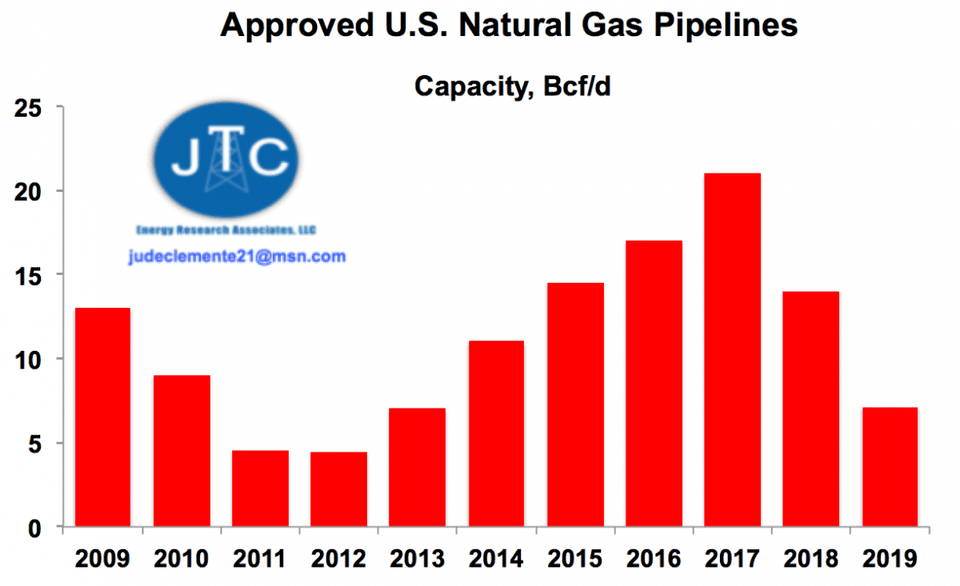The Great American Oil and Natural Gas Pipeline Boom

This makes sense:
since 2008, U.S. crude oil and gas production have respectively boomed 150% to
12.3 million b/d and 60% to 90 Bcf/d.
Pipelines get
approved in the first place because rising usage demands it.
Originating in
Texas, we track nearly 40 pipelines covering 11,000 miles either being built or
in pre-construction development.
Just a few days
ago the DC Circuit Court of Appeals upheld FERC orders approving the 197-mile,
1.7 Bcf/d Atlantic Sunrise Project (connecting PA gas to mid-Atlantic markets),
denying numerous objections from anti-gas environmental groups.
The court backed
FERC's position of market need for the pipeline, specifically citing evidence
that there were contracts for 100% of the capacity.
Indeed, very
quietly, the International Energy Agency reports that the U.S. led the world in
2018 for new oil demand (+540,000 b/d) and new gas demand (+7.8 Bcf/d). (read
that again).
For comparison,
the annual increase in U.S. gas demand in 2018 was equivalent to the UK's
current consumption.
As the main sector
of use, U.S. gas demand for electricity has soared 60% since 2008 to 30 Bcf/d.
Just as
importantly, we are building an immense oil and gas export complex to bring
reliable and affordable fuels to an energy-deprived world.
Now the largest
oil and gas producer, we will probably become the largest exporter of both
within five years.
In the rich
Western economies, for instance, oil and gas supply over 60% of all energy.
Gas is especially
the go-to fuel to lower emissions while backing up wind and solar power.
The EIA is
currently tracking over 160 new U.S. gas pipeline projects, with a staggering
113 Bcf/d of capacity.
In Appalachia (OH,
WV, PA), for instance, where nearly 40% of U.S. natural gas is produced, there
is a whopping $32 billion in new pipelines in the works.
This will add 23
Bcf/d of new takeaway capacity to a region that already produces 33 Bcf/d.
"Northeast
region slated for record natural gas pipeline capacity buildout in 2018;"
"Another New Gas Pipeline Is Coming to the Permian Basin."
These build-outs
are essential.
The U.S.
Department of Energy reports that the majority of new power plants in this
country will be natural gas, a hefty 235,000 MW of additional gas capacity in
the coming decades.
It could actually
be even higher given how low gas prices are.
Lowering the
ability of other power sources to compete, some expect U.S. gas prices to not
clear the $3 range until 2026 at the earliest
Gas pipelines are
good for the environment too: BNEF reports that more natural gas "has done
more to curb U.S. carbon emissions in the past decade than any other single
factor, including new renewable build."
Down in Texas, the
Permian pipeline boom continues apace.
And for good
reason: the Permian basin now produces 33% of U.S. crude oil and 16% of natural
gas.
With the largest
U.S. oil and gas discovery ever in December, doubling our reserves, the
Permian's future remains very bright.
In particular,
crude pipelines have low barriers to entry.
The Permian is
expected to quickly go from a bottleneck region to potentially having more pipe
than crude production can fill.
One key goal for
Permian producers is to soar the play's 400,000 b/d capacity to Corpus Christi,
Texas for export.
By the end of the
year, there should be some 1.7 million b/d of capacity to Corpus Christi.
Surpassing the
Port of Houston, the Port of Corpus Christi will likely become the largest
crude export terminal in the U.S. over the next seven to 10 years.
Midstream
companies are now building 4.6 million b/d of crude capacity out of the Permian
to the Gulf Coast, set to enter service from end-2019 to the first-half 2021.
Places like New
York and New England have shown that pipeline blocking means energy prices that
are 50% or higher above the national average, hurting American families and
businesses.
Other key issues
supporting pipelines include President Trump's Executive Order to stop
individual states and governors from blocking projects that could greatly
benefit other states.
And the hot topic
of enhanced cybersecurity is critical for the oil and gas industry.
Reducing leaks and
accidents is a top priority because it stops lost product and maintains a
corporation's invaluable reputation.
In fact, the oil
and gas industry has been pushing for more communication with federal
regulators.
For example, the
Interstate Natural Gas Association of America just appointed ex-TSA offifical
Michael Isper to the newly created role of director of security, reliability
and resilience.
The key takeaway
of the ongoing U.S. pipeline success story is simple: bet on oil and natural
gas.
The U.S. Department of Energy projects that oil and natural gas will still supply over 65% of our energy in 2050.
